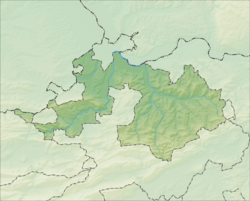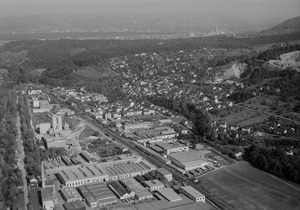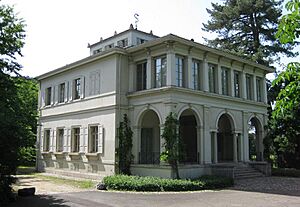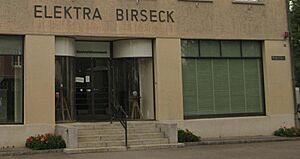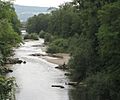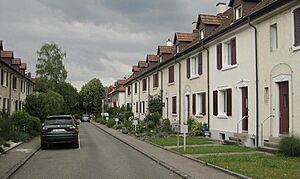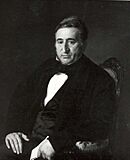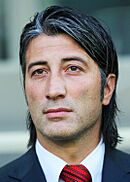Münchenstein facts for kids
Quick facts for kids
Münchenstein
|
||
|---|---|---|
 |
||
|
||
| Country | Switzerland | |
| Canton | Basel-Landschaft | |
| District | Arlesheim | |
| Area | ||
| • Total | 7.19 km2 (2.78 sq mi) | |
| Elevation | 297 m (974 ft) | |
| Population
(Jun 2021 )
|
||
| • Total | 12,128 | |
| • Density | 1,686.8/km2 (4,369/sq mi) | |
| Postal code |
4142
|
|
| Surrounded by | Arlesheim, Basel (BS), Muttenz, Reinach | |
Münchenstein (which is Minggestai in Swiss German) is a town in Switzerland. It's located in the Arlesheim district, within the canton of Basel-Landschaft.
Contents
- Münchenstein's Story Through Time
- Münchenstein's Location and Landscape
- Münchenstein's Coat of Arms
- People of Münchenstein
- Population Changes Over Time
- Learning and Schools in Münchenstein
- Important Historical Places
- Münchenstein's Economy
- Religion in Münchenstein
- Getting Around Münchenstein
- Clubs and Groups
- Famous People from Münchenstein
- See also
Münchenstein's Story Through Time
Münchenstein has a long history. It was first mentioned in old records in 1196 as Kekingen. Later, in 1270, it was called Geckingen.
The name Munchenstein appeared in 1279. This name means "the rock of the castle of the Münchs". The "Münchs" were the people who built the castle. "Stein" means stone, referring to the castle's strong foundations.
In 1259, a small village and a mill were mentioned. They were owned by a church in Basel. By 1270, the village was officially named Geckingen in church documents.
The Münch family didn't own the castle and village for long. In 1324, they had to give it to the Count of Pfirt. After he died, Münchenstein became part of Austria.
A big earthquake hit Basel in 1356. Many buildings and castles were damaged, including Münchenstein castle. But it was quickly fixed!
In 1470, the Münchs faced money problems. They had to give the village and castle to the city of Basel. This meant Basel took control of Münchenstein for the first time.
The castle was destroyed during a revolution in 1797/98.
A railway line, the Jurabahn Basel-Delémont, opened in 1875. This connected Münchenstein to other towns. The name Münchenstein became official in 1881.
A terrible train accident happened in Münchenstein in 1891. A crowded passenger train fell through a bridge. Many people were hurt or died. This was one of Switzerland's worst train disasters.
In 1957, a famous font called Helvetica was created here. It was first known as Das Neue Haas Grotesk.
Münchenstein hosted a big garden and landscaping exhibition called "Grün 80" in 1980. In 1997, a new sports and culture center called Kuspo opened.
In 2011, a tram accident happened. Europe's second longest tramline, line 10, crashed into a house.
Münchenstein's Location and Landscape
Münchenstein covers an area of about 7.18 square kilometers (2.77 square miles). A good part of this land is covered by forests (24.1%). About 15.6% is used for farming.
Most of the land (58.1%) has buildings or roads. This includes homes, factories, and transportation routes. There are also parks and sports fields.
The Birs river flows through Münchenstein. The town is located about 297 meters (974 feet) above sea level.
Münchenstein is divided into three main areas: Münchenstein Dorf, Neumünchenstein, and Neue Welt/Brüglingen. The northern part of the town borders the canton of Basel-City. Other nearby towns include Muttenz, Arlesheim, and Reinach.
Münchenstein's Coat of Arms
The blazon of Münchenstein's coat of arms shows a black monk walking on a silver background. He is wearing red shoes. This symbol comes from the official seal of the old Münch family.
People of Münchenstein
Münchenstein has a population of about 11,841 people. Around 20% of the people living here are from other countries.
Most people in Münchenstein speak German (about 87%). Italian is the second most common language, followed by French.
In 2010, about 5.8% of the population were young children (0-6 years old). Teenagers (7-19 years old) made up about 13.8% of the population. There are also many adults and seniors living in the town.
Most people in Münchenstein are married or have never been married. There are many different types of households, including single-person homes and families with children.
Population Changes Over Time
This chart shows how Münchenstein's population has grown over the years:

Learning and Schools in Münchenstein
Münchenstein has many schools for different ages:
- Kindergarten: Ameisenhölzli, Bündten, Dillacker, Ehinger, Lange Heid, Neuewelt, Teichweg
- Primary Schools: Lange Heid, Pavillon Dillacker, Loog, Löffelmatt, Neue Welt
- Secondary Schools: Loog, Lärchen
- Other Schools: Gymnasium Münchenstein, Heilpädagogische Schule, the Music School, Rudolf Steiner Schule, TSM-Schulzentrum für Kinder und Jugendliche mit Behinderungen, Volkshochschule Basel Erwachsenenbildung Münchenstein und Erwachsenenbildung Gymnasium Münchenstein, Bildungszentrum Gesundheit BZG Basel-Stadt
Many people in Münchenstein have finished high school or gone on to higher education like university.
The town also has a public library called the Gemeindebibliothek. In 2008, it had over 18,000 books and other items. It loaned out more than 94,000 items that year!
Important Historical Places
Several places in Münchenstein are considered very important Swiss heritage sites. These include the Bruckgut farming estate, the Foundation Herzog, and the gardens and pool of St Jakob.
The Kutschenmuseum (Carriage Museum), Schaulager, and Villa Merian are also important. The entire Brüglingen area is a protected heritage site.
Museums to Explore
- Schaulager: This is a special place that's a mix of a museum, an art storage building, and a research center for art. It's mostly for art experts, but it also opens to the public for special events and yearly exhibitions.
- Kutschenmuseum: This is a private museum that shows old coaches and carriages. It's part of the Basel Historical Museum and is located in a barn in the Park im Grünen.
- Watermill Museum Brüglingen: This museum is in an old mill from the late Gothic period. It's located in the Neue Welt area.
- Elektrizitätsmuseum: This is the Museum of Electricity.
- Frog Museum: This private museum is in the Newmünchenstein area. It has over 13,600 Frogs of all shapes, sizes, and materials!
- Laboratorium für Photographie: A laboratory for photography.
- St. Jakobshalle: A large indoor arena.
Cool Places to See
- The Münchenstein Castle ruins are a famous landmark. They sit on a long, narrow rock above the village.
- The village center and the Trotte (an old wine press building) are at the foot of the castle rock.
- The beautiful Villa Merian was built in 1711 and has a lovely English Garden.
- The Neue Welt area is the northernmost part of Münchenstein, along the Birs river.
- The hammer mill (Hammerschmiede) was built in 1660. It's the oldest building in the Neue Welt. It was restored in 1970 and is now a protected monument.
- The Villa Ehinger was built in 1832 by architect Melchior Berri.
- The Wasserhaus residential area was designed by famous architects in 1920/21.
Münchenstein's Economy
Münchenstein has many different types of jobs. In 2005, there were about 153 people working in farming. Over 1,800 people worked in factories and construction. The biggest number of jobs, over 6,100, were in the service sector. This includes jobs in shops, offices, and healthcare.
Many people travel into Münchenstein for work. About 16% of these workers come from outside Switzerland. Most people use public transport or a private car to get to work.
Elektra Birseck Münchenstein (EBM), an energy company, has its main office here.
Religion in Münchenstein
According to a 2000 survey, about 36% of the people in Münchenstein belonged to the Swiss Reformed Church. About 32% were Roman Catholic.
There were also people who belonged to other Christian churches. Some people were Muslim or Jewish. Others were Buddhist or Hindu. About 17% of the population did not belong to any church.
Getting Around Münchenstein
Baselland Transport runs two tram lines and three bus lines through Münchenstein. Tramline 10 is very long, it's the second longest tramline in Europe!
The Swiss Federal Railways also have a train station near the center of the village.
Clubs and Groups
Münchenstein has many different clubs and associations. The IGOM (Interessengemeinschaft der Ortsvereine Münchenstein) is an alliance that includes 75 recognized clubs and groups.
Famous People from Münchenstein
Many interesting people have connections to Münchenstein:
- The Münch family was a very important family in Basel from 1185 to 1759.
- Christoph Merian (1800–1858) was a banker and businessman who started the Christoph Merian Stiftung.
- Melchior Berri (1801–1854) was a Swiss architect.
- Anna Hegner (1881–1963) was a violinist, composer, and music teacher who lived in Münchenstein.
- Irène Zurkinden (1909-1987) was a Swiss painter who grew up here.
- Philipp Aeby (born 1968) grew up in Münchenstein and is now a CEO.
- Mathis Künzler (born 1978) is a Swiss actor who grew up in the area.
Sports Stars
Münchenstein has also been home to several famous sports figures:
- Murat Yakin (born 1974) is a former Swiss football player and coach. He played many games for Switzerland's national team.
- Hakan Yakin (born 1977) is another former Swiss footballer and coach who grew up in Münchenstein. He also played for the national team.
- Benjamin Huggel (born 1977) is a former Swiss footballer and coach who grew up here.
- Roger Federer (born 1981), one of the greatest tennis players of all time, grew up in Münchenstein.
- Marco Chiudinelli (born 1981), another tennis player, also grew up in Münchenstein.
See also
 In Spanish: Münchenstein para niños
In Spanish: Münchenstein para niños




